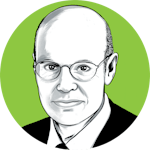Opinion editor's note: Strib Voices publishes a mix of commentary online and in print each day. To contribute, click here.
•••
The signature scene from the TV show most associated with Minneapolis features Mary Tyler Moore tossing her hat near Dayton's Department Store on a crowded Nicollet Mall.
That indelible image was filmed 50-plus years ago. Today, Dayton's — and the throngs — are gone. Mary is still there, but in statue form, frozen in mid-tam-toss in what seems to reflect the mall's past, not what its future should be. And that, according to Minneapolis Mayor Jacob Frey, is "the main street of our state of Minnesota."
Frey, who began an interview by saying, "Allow me to be a little bit aspirational," said the mall is "the gateway, not just to downtown, but coming from the east side to the western half of our country, crossing and over the Mississippi River. The Nicollet Mall begins right there, and it has great potential, if we do this right, to be a place of celebration, of congregation and truly active."
Mayors, particularly amid challenging times for cities across the country, should be aspirational — inspirational, even — in efforts to revitalize downtowns and, by extension, cities themselves, which still serve as state and even regional economic engines.
So Minneapolitans and others who commute downtown should keep that vision in context as the city and the Metropolitan Council consider making Nicollet a pedestrian mall by moving buses off to surrounding streets.
Three options to do so, with a likely implementation in 2026, were displayed last Tuesday at the IDS Crystal Court. The crowds reviewing the schematics reflected how people care not only about their bus lines but the mall as well.
"I'm really excited that people are here and investing a bit of time over their lunch hour to give us this feedback," said Kathleen Mayell, transportation planning manager with the City of Minneapolis Public Works department.
The proposals, she said, are "really complex; there are lots of trade-offs with the different options." Some would require partial street reconstruction in order to move the current five routes, which serve about 11,600 riders in 650 buses every weekday. Those buses crawl at speeds averaging 5 mph and idle about half of the time due to stoplights. And they're unable to pass buses ahead of them, unlike some surrounding streets where buses are able to move more nimbly between two lanes.
"The worst thing a restaurant can have is everybody out on a happy hour Tuesday afternoon with an idling diesel bus right next to it," said Frey, describing one of the obvious challenges of re-establishing Nicollet Mall as a desired destination.
But it isn't just about rerouting vehicles. It's about rerouting people, too.
"There's a couple pieces that we need to make this happen," said Frey. "We need to get the buses off. The second is get the people on. It's not enough to do one of the two."
That's a view shared by Yingling Fan, a professor in the Humphrey School's urban and regional planning area. "Just the arrangement of removing buses will have limited impact, [unless] it's being paired with significant efforts to attract very unique kinds of events like restaurants and entertainment and even recreational efforts that will make the street more lively," she said.
Activation is indeed key, said Frey, who indicated an initial two-year budget figure of $550,000 is slated for such initiatives. Beyond activation, a more active retail scene is also needed — albeit not one akin to the Mary Tyler Moore era of department stores like Dayton's, Donaldson's and Powers, but powerful-yet-small unique retail outlets. This exists in the North Loop and East Hennepin neighborhoods already, said Frey, who added that he's encouraging building owners to break up spaces to accommodate a similar transformation on the mall.
Eliminating buses and encouraging buskers and other forms of positive street life cannot overlook another challenge facing cities nationwide: the perception and all-too-often reality of downtown crime, from which Nicollet Mall is not immune. Frey acknowledged the issue and said that ongoing mall law-enforcement efforts endure, and that ultimately more people would be a force multiplier to those efforts.
"The main strategy here is you get more positive activity that helps reduce the sensation of negative activity," said Frey. "It also prevents a lot of the negative activity from happening to begin with, because you get eyes on the street, people who are checking out what's going on."
Fan concurs. "The best surveillance is people's surveillance, just a lot of people using the public space to have safety."
There's no one national or international model to replicate, said Frey, who referred, despite differences in scale and scope, to Pearl Street in Boulder as a small example and the National Mall in Washington on a much larger scale. Internationally, he mentioned Minneapolis' sister city Kuopio, Finland, as a city that goes much further, reserving every other street for pedestrians and cyclists.
Nicollet Mall was already recently redesigned, with a reopening in 2017. So the mayor and Minneapolis leaders don't have to overly invest in infrastructure, but think creatively about attracting people the way the mall used to and should do again. In advancing their plan they should indeed be aspirational and even historical, like the idea of redeploying an activation tactic of a farmers market, a natural attraction that's been universal and elemental across the world and across time.
Once a weekly feature on the mall, it was simple and repeatable, and it consistently brought people from all societal sectors together — a concept, like revitalizing the mall itself, worthy of tossing up your hat for.
Rash: Don't dim America's 'beacon of hope'
The fiscal impact of the bill will be big, but it won't be beautiful
Rash: American campuses need international students
Rash: Unite on the right to, and rights of, a free press


